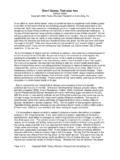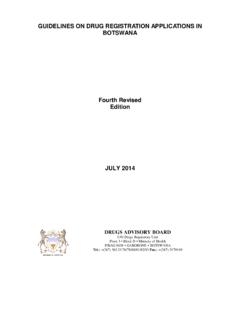Transcription of 155511 REMERON APM - Auro Pharma
1 PRODUCT MONOGRAPH. Pr AURO-MIRTAZAPINE. (mirtazapine). Tablets 15 mg, 30 mg and 45 mg House Standard ANTI-DEPRESSANT. Auro Pharma Inc. 3700 Steeles Avenue West, Suite # 402. Woodbridge, Ontario, L4L 8K8, CANADA. Submission Control No: 161593 Date of Preparation: August 29, 2013. 1. Table Of Contents PART I: HEALTH PROFESSIONAL .. 3. SUMMARY PRODUCT INFORMATION .. 3. INDICATIONS AND CLINICAL USE .. 3. CONTRAINDICATIONS .. 4. WARNINGS AND PRECAUTIONS .. 4. ADVERSE REACTIONS .. 10. DRUG INTERACTIONS .. 16. DOSAGE AND ADMINISTRATION .. 19. OVERDOSAGE .. 21. ACTION AND CLINICAL PHARMACOLOGY .. 22. SPECIAL HANDLING INSTRUCTIONS .. 24. STORAGE AND STABILITY .. 24. DOSAGE FORMS, COMPOSITION AND PACKAGING .. 25. PART II: SCIENTIFIC INFORMATION .. 26. PHARMACEUTICAL INFORMATION .. 26. CLINICAL TRIALS .. 27. DETAILED PHARMACOLOGY .. 28. TOXICOLOGY .. 31. REFERENCES .. 34. PART III: CONSUMER .. 36. 2. Pr AURO-MIRTAZAPINE.
2 (mirtazapine). House Standard PART I: HEALTH PROFESSIONAL INFORMATION. SUMMARY PRODUCT INFORMATION. Route of Dosage Form/. All Nonmedicinal Ingredients Administration Strength oral Tablets/15, 30 and Lactose Monohydrate, Hydroxypropyl cellulose, 45 mg Maize Starch, Silica, colloidal anhydrous, Low substituted hydroxy propyl cellulose, Magnesium Stearate Coating Ingredients: Opadry Yellow 20A52560 (15 mg): It contains Hydroxypropyl cellulose, Hydroxypropyl cellulose (2910/ Hypromellose 6 cp), Titanium dioxide &. Iron oxide yellow. Opadry Brown 20A56788 (30 mg): It contains Hydroxypropyl cellulose, Hydroxypropyl cellulose (2910/ Hypromellose 6 cp), Titanium dioxide, Iron oxide yellow, Iron oxide red & Iron oxide black. Opadry White 20A58806 (45 mg): It contains Hydroxypropyl cellulose, Hydroxypropyl cellulose (2910/ Hypromellose 6 cp) & Titanium dioxide. INDICATIONS AND CLINICAL USE. Adults AURO-MIRTAZAPINE (mirtazapine) is indicated for the symptomatic relief of depressive illness.
3 Long-term use of AURO-MIRTAZAPINE. The efficacy of mirtazapine in maintaining a response in patients with major depressive disorder for up to 40 weeks following 8 - 12 weeks of initial open-label treatment was demonstrated in a placebo-controlled trial. Nevertheless, the physician who elects to use AURO-MIRTAZAPINE. for extended periods should periodically evaluate the long-term response of the individual patient to the drug. 3. Geriatrics (> 65 years of age): Evidence from clinical trials and experience suggests that use in geriatric populations may be associated with differences in safety or effectiveness. A brief discussion can be found in the appropriate sections [see WARNINGS AND PRECAUTIONS, Neurologic, Somnolence; Special Populations, Geriatrics (> 65 years of age); DOSAGE AND ADMINISTRATION; ACTION. AND CLINICAL PHARMACOLOGY, Special Populations and Conditions, Geriatrics]. Pediatrics (< 18 years of age): AURO-MIRTAZAPINE is not indicated for use in patients below the age of 18 years (see WARNINGS AND PRECAUTIONS, General, Potential Association with Behavioural and Emotional Changes, Including Self-Harm; see also ADVERSE REACTIONS/Pediatrics, DOSAGE AND ADMINISTRATION and ACTION AND CLINICAL PHARMACOLOGY.)
4 Special Populations and Conditions/Pediatrics). CONTRAINDICATIONS. Hypersensitivity: AURO-MIRTAZAPINE is contraindicated in patients who are known to be hypersensitive to the drug or any of its components. For a complete listing, see DOSAGE. FORMS, COMPOSITION AND PACKAGING. Monoamine Oxidase Inhibitors: In patients receiving agents that may affect the serotonergic neurotransmitter systems in combination with a monoamine oxidase (MAO) inhibitor, there have been reports of serious, sometimes fatal, reactions including hyperthermia, rigidity, myoclonus, autonomic instability with possible rapid fluctuations of vital signs, and mental status changes that include extreme agitation progressing to delirium and coma. These reactions have also been reported in patients who have recently discontinued (SSRI) Selective Serotonin Reuptake Inhibitor treatment and have begun treatment on a MAO inhibitor.
5 Some cases presented with features resembling serotonin syndrome or neuroleptic malignant syndrome (see WARNINGS. AND PRECAUTIONS, Neurologic, Serotonin Syndrome/Neuroleptic Malignant Syndrome). Therefore, AURO-MIRTAZAPINE should not be used in combination with MAO inhibitors (including the antibiotic linezolid, and the thiazine dye methylthioninium blue (methylene blue), which are less well-known examples of MAO inhibitors) or within a minimum of 2 weeks of terminating treatment with MAO inhibitors. Treatment with AURO-MIRTAZAPINE should then be initiated cautiously and dosage increased gradually until optimal response is reached. MAO inhibitors should not be introduced within 2 weeks of cessation of therapy with AURO- MIRTAZAPINE. WARNINGS AND PRECAUTIONS. General POTENTIAL ASSOCIATION WITH BEHAVIOURAL AND EMOTIONAL CHANGES, INCLUDING SELF-HARM. Pediatrics: Placebo-Controlled Clinical Trial Data 4.
6 Recent analyses of placebo-controlled clinical trial safety databases from SSRIs (Selective Serotonin Reuptake Inhibitors) and other newer anti-depressants suggest that use of these drugs in patients under the age of 18 may be associated with behavioural and emotional changes, including an increased risk of suicidal ideation and behaviour over that of placebo. The small denominators in the clinical trial database, as well as the variability in placebo rates, preclude reliable conclusions on the relative safety profiles among these drugs. Adults and Pediatrics: Additional Data There are clinical trial and post-marketing reports with SSRIs and other newer antidepressants, in both pediatrics and adults, of severe agitation-type adverse events coupled with self-harm or harm to others. The agitation-type events include akathisia, agitation, disinhibition, emotional lability, hostility, aggression and depersonalization.
7 In some cases, the events occurred within several weeks of starting treatment. Rigorous clinical monitoring for suicidal ideation or other indicators of potential for suicidal behaviour is advised in patients of all ages. This includes monitoring for agitation type emotional and behavioural changes. Discontinuation Symptoms Patients currently taking mirtazapine should NOT discontinue treatment abruptly, due to risk of discontinuation symptoms. At the time that a medical decision is made to discontinue an SSRI or other newer anti-depressant drug, a gradual reduction in the dose, rather than an abrupt cessation, is recommended. Lactose Lactose is a non-medicinal ingredient in AURO-MIRTAZAPINE tablets. Therefore, patients with rare hereditary problems of galactose intolerance or glucose-galactose malabsorption should not take AURO-MIRTAZAPINE tablets. Agranulocytosis In pre-marketing clinical trials, two (one with Sj gren's Syndrome) out of 2,796 patients treated with mirtazapine tablets and one patient treated with imipramine developed agranulocytosis.
8 In all three cases, the patients recovered after the drug with which they were being treated was stopped. In the post-marketing period with mirtazapine, very rare cases of agranulocytosis have been reported, mostly reversible, but in some cases fatal. Fatal cases have mostly concerned patients above 65 years of age, although there has been at least one such fatality in a younger patient. Patients who are to receive mirtazapine should be warned about the risk of developing agranulocytosis, and advised to contact their physician if they experience any indication of infection such as fever, chills, sore throat, mucous membrane ulceration. If a patient develops a sore throat, fever, stomatitis or other signs of infection, along with a low WBC count, treatment with mirtazapine tablets should be discontinued and the patient should be closely monitored. 5. Discontinuation of Treatment with Mirtazapine When discontinuing treatment, patients should be monitored for symptoms which may be associated with discontinuation, , dizziness, abnormal dreams, sensory disturbances including paresthesia and electric shock sensations), agitation, anxiety, fatigue, confusion, headache, tremor, nausea, vomiting and sweating or other symptoms which may be of clinical significance (see ADVERSE REACTIONS).
9 A gradual reduction in the dosage over several weeks, rather than abrupt cessation, is recommended whenever possible. If intolerable symptoms occur following a decrease in the dose or upon discontinuation of treatment, dose titration should be managed on the basis of the patient's clinical response (see ADVERSE REACTIONS and DOSAGE AND ADMINISTRATION). The following additional precautions are listed alphabetically. Carcinogenesis and Mutagenesis See TOXICOLOGY for animal data. Cardiovascular Cholesterol/Triglycerides: In short-term controlled studies, non-fasting cholesterol increases of > 20% above the upper limits of normal were observed in 15% of patients taking mirtazapine compared to 7% for placebo. In these same studies, non-fasting triglycerides increased to > 500 mg/dl in 6% of patients taking mirtazapine compared to 3% for placebo. Concomitant Illness Use in Patients with Concomitant Illness: Clinical experience with mirtazapine in patients with concomitant systemic illness is limited.
10 Accordingly, care is advisable in prescribing mirtazapine for patients with diseases or conditions that affect metabolism or hemodynamic responses. Cardiovascular-Related History Mirtazapine has not been systematically evaluated or used to any appreciable extent in patients with a recent history of myocardial infarction or other significant heart disease. Mirtazapine was associated with significant orthostatic hypotension in early clinical pharmacology trials with normal human volunteers. Orthostatic hypotension was infrequently observed in clinical trials with depressed patients. Mirtazapine should be used with caution in patients with known cardiovascular or cerebrovascular disease that could be exacerbated by hypotension (history of myocardial infarction, angina or ischemic stroke) and conditions that would predispose patients to hypotension (dehydration, hypovolemia, and treatment with antihypertensive medication).

![[Product Monograph Template - Schedule D]](/cache/preview/b/f/c/5/9/9/f/5/thumb-bfc599f58969b8bff3fb0f7d9d95ed1e.jpg)



